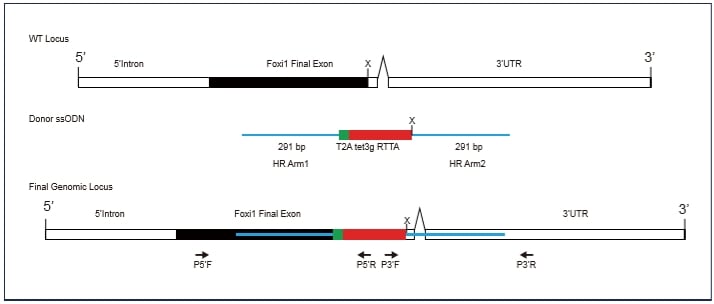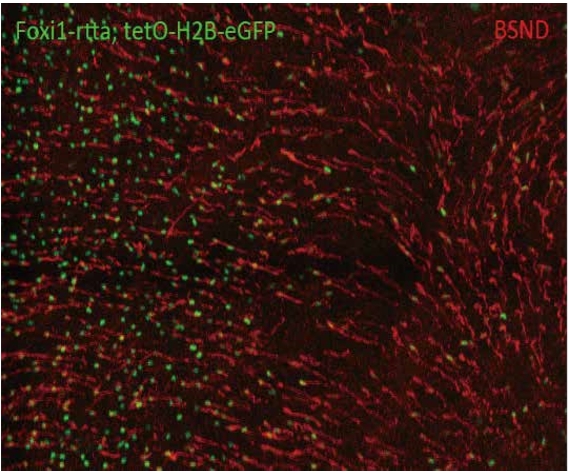Using Long ssDNA for the Generation of Foxi1-rtTA Transgenic Mice
Introduction
Mouse disease models are invaluable tools for research. With recent advance in CRISPR/Cas9 technologies, the efficiency of generating mouse models has been greatly improved.
Foxi1 (Forkhead Box I1) is a primary transcription factor required for the specification of ionocytes, which are the major source of transcripts of the cystic fibrosis transmembrane conductance regulator (CFTR) in both mouse and human. To study the function of ionocytesduring normal homeostasis and disease such as cystic fibrosis, an inducible Foxi1 driver is desirable. This project aims to generate a tetracycline-inducible mouse line (Foxi1-rtTA), with reverse tetracycline transactivator (rtTA) protein fused after the final exon of the FOXi1 gene. As a functional proof of principle, these Foxi1-rtTA driver mice were crossed with tetO-H2B-eGFP mice, will generate offspring where Foxi1 positive cells are identifiable by GFP expression, following doxycycline induction. This mouse model can be used to conditionally ablate the ionocyte when crossed to a tetO-DTA mouse, or additional Cre mediated excisions when crossed to a tetO-Cre mouse.
Knockin of genes, like rtTA, for mouse model generation were traditionally done by microinjecting CRISPR ribonucleoprotein (RNP) with plasmids or dsDNA as DNA donor templates into the embryos. However, knockin efficiencies of plasmids and dsDNA have been reported to be unstable and relatively low (5-30%) depending on target design1-8. Several publications have suggested that ssDNA donor templates can significantly improve the editing efficiency (30-60%)6-9, thus minimizing cost of zygotes preparation, microinjection, breeding, and genotyping. In this project, long ssDNA was chosen as the donor template for rtTA insertion.

Figure 1. Strategy for developing Foxi1-rtTA mice
gRNA design: CUAACGGUAUUCCCC, targeting Foxi 1 gene at chr 11 34,205,534, final exon of Forkhead Box I1 (FOXI1) gene.
ssDNA design: rtTA encoding DNA sequence with 291bp homology arms complimentary to the gRNA cutting site. Total ssDNA length is 1392nt.
Expression strategy: This project used the Tet-On system to generate a tetracycline-inducible mouse line (Foxi1-rtTA) with reverse tetracycline transactivator (rtTA) protein fused to the final exon of Forkhead Box I1 (FOXI1) gene. Foxi1-rtTA and tetO-H2B-eGFP mice were crossed to enable inducible GFP expression. Briefly, in F2 mice, following Foxi1 and rtTA expression, the rtTA protein binds to the tetracycline operator (tetO) and activates H2B-eGFP transcription in the presence of doxycycline, enabling nuclear eGFP expression in Foxi1 positive cells.
Table 1. Genotyping results
| KI Gene Locus | Insert Length | Animals Born | Targeted Animals |
|---|---|---|---|
| Foxi1 | 1392nt | 27 | 4 homozygous insertions 2 heterozygous insertions |
CRISPR RNP complex and ssDNA (1392nt in length) donor template were microinjected into 150 mouse zygotes to generate Foxi1-rtTA mice. After implantation, 27 animals were born, consisting of 4 homozygous and 2 heterozygous rtTA knockin mice, therefore resulting in a 22% editing efficiency.

Figure2. Functional staining results
Following crossing of Foxi1-rtTA founders to tetO-H2B-eGFP mice, the resulting F2 offsprings were loaded with doxycycline for 3 days. Olfactory epithelium wholemount shows nuclear H2B-eGFP expression in ionocytes stained for Barttin protein (BSND).
Conclusion
By using CRISPR/Cas9 technology and long ssDNA as the HDR donor template, a Foxi1-rtTA knockin mouse model was successfully generated with an efficiency of 22%, which was achieved through a single experiment. Breeding the Foxi1-rtTA knockin mouse model to the tetO-H2B-eGFP mouse, successfully placed H2B-eGFP expression under the control of the Foxi1 promoter following the addition of doxycycline. This strategy of combining CRISPR/Cas9 with Tet-On/Off system can be adopted for generating conditional knockout and knockin mouse models with GFP labeling for easier detection.
References
- Aida, T., Nakade, S., Sakuma, T. et al. Gene cassette knock-in in mammalian cells and zygotes by enhanced MMEJ. BMC Genomics 17, 979 (2016).
- Yang, H., Wang, H., Shivalila, C. S., Cheng, A. W., Shi, L. & Jaenisch, R. 2013. One‐Step generation of mice carrying reporter and conditional alleles by CRISPR/Cas‐mediated genome engineering. Cell 154, 1370–1379.
- Inui M, et al. Rapid generation of mouse models with defined point mutations by the CRISPR/Cas9 system. Sci Rep. 2014;4.
- Ma Y, et al. Generating rats with conditional alleles using CRISPR/Cas9. Cell Res. 2014;24:122–5.
- Horii T, Hatada I. Challenges to increasing targeting efficiency in genome engineering. J Reprod Dev. 2016;62:7–9.
- Quadros, R.M., Miura, H., Harms, D.W. et al. Easi-CRISPR: a robust method for one-step generation of mice carrying conditional and insertion alleles using long ssDNA donors and CRISPR ribonucleoproteins. Genome Biol 18, 92 (2017).
- Miura, H., Quadros, R., Gurumurthy, C. et al. Easi-CRISPR for creating knock-in and conditional knockout mouse models using long ssDNA donors. Nat Protoc 13, 195–215 (2018).
- Miyasaka, Y., Uno, Y., Yoshimi, K. et al. CLICK: one-step generation of conditional knockout mice. BMC Genomics 19, 318 (2018).
- Gurumurthy, C.B., O’ Brien, A.R., Quadros, R.M. et al. Reproducibility of CRISPR-Cas9 methods for generation of conditional mouse alleles: a multi-center evaluation. Genome Biol 20, 171 (2019).
GenScript CRISPR RNP & ssDNA Service
- Like (3)
- Reply
-
Share
About Us · User Accounts and Benefits · Privacy Policy · Management Center · FAQs
© 2025 MolecularCloud



